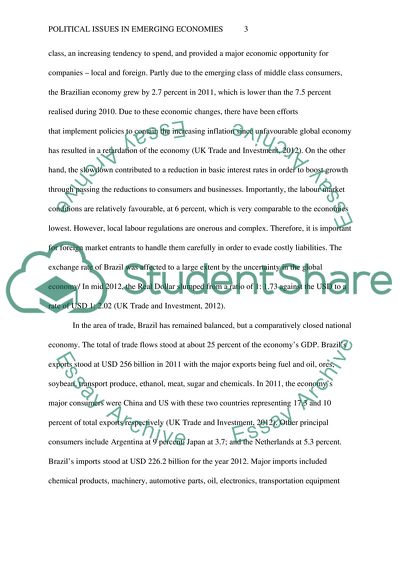Cite this document
(Political Issues in Emerging Economies Coursework Example | Topics and Well Written Essays - 2250 words, n.d.)
Political Issues in Emerging Economies Coursework Example | Topics and Well Written Essays - 2250 words. https://studentshare.org/politics/1798917-if-you-wanted-to-conduct-business-in-an-emerging-country-such-as-brazil-what-are-the-political-issues-you-might-face-briefly-research-about-the-country-and-develop-your-strategies-for-an-international-company-that-moves-there-the-strategies-recommen
Political Issues in Emerging Economies Coursework Example | Topics and Well Written Essays - 2250 words. https://studentshare.org/politics/1798917-if-you-wanted-to-conduct-business-in-an-emerging-country-such-as-brazil-what-are-the-political-issues-you-might-face-briefly-research-about-the-country-and-develop-your-strategies-for-an-international-company-that-moves-there-the-strategies-recommen
(Political Issues in Emerging Economies Coursework Example | Topics and Well Written Essays - 2250 Words)
Political Issues in Emerging Economies Coursework Example | Topics and Well Written Essays - 2250 Words. https://studentshare.org/politics/1798917-if-you-wanted-to-conduct-business-in-an-emerging-country-such-as-brazil-what-are-the-political-issues-you-might-face-briefly-research-about-the-country-and-develop-your-strategies-for-an-international-company-that-moves-there-the-strategies-recommen.
Political Issues in Emerging Economies Coursework Example | Topics and Well Written Essays - 2250 Words. https://studentshare.org/politics/1798917-if-you-wanted-to-conduct-business-in-an-emerging-country-such-as-brazil-what-are-the-political-issues-you-might-face-briefly-research-about-the-country-and-develop-your-strategies-for-an-international-company-that-moves-there-the-strategies-recommen.
“Political Issues in Emerging Economies Coursework Example | Topics and Well Written Essays - 2250 Words”. https://studentshare.org/politics/1798917-if-you-wanted-to-conduct-business-in-an-emerging-country-such-as-brazil-what-are-the-political-issues-you-might-face-briefly-research-about-the-country-and-develop-your-strategies-for-an-international-company-that-moves-there-the-strategies-recommen.


